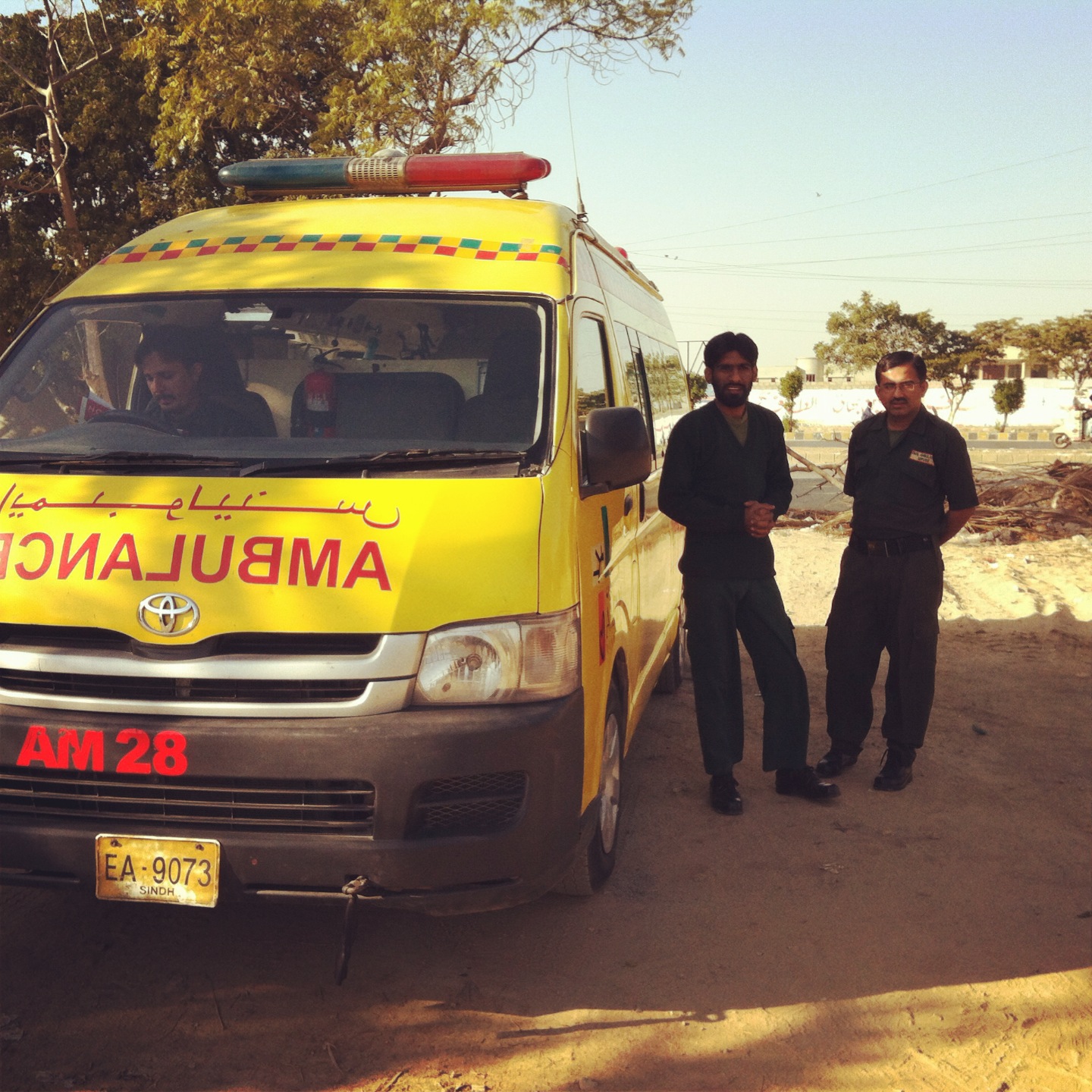Feb. 11, 2014 – Andrea Titus
Walking into the dusty command and control center of the Edhi Foundation’s ambulance service in Karachi, Pakistan, I am immediately struck by the modesty of the space. A row of metal chairs sit in front of old land line telephones. Three men in red shirts annotate a white board with a count of calls from city subdivisions. The phones ring steadily, but the ambience is calm. This is despite the fact that, according to the center’s manager, around 6,000 calls will be routed through command and control in any given 24 hours, many of these dispatched to the organization’s 300 ambulances spread across the city at strategically located key points.
When Abdul Sattar Edhi founded his ambulance service in the 1950s, it was the only one of its kind. Now the Edhi Foundation operates just one of a handful of ambulance services in Karachi, ranging from run-down vans with first aid kits to state-of-the-art vehicles with advanced life support equipment. When I arrived in the city with one of my classmates this past January to do field research on financial and operational challenges facing ambulance services in the region, disentangling the map of providers had felt like an enormous obstacle. Now, however, the picture was becoming clearer, and the Edhi Foundation’s office emerged as iconic in my mind – a snapshot of the shared challenges and opportunities facing first responders in a diverse city of 14-20 million people.
Many of these challenges are what you might expect to find in any other rapidly developing metropolis. In the absence of a standardized address system, for example, each incoming call becomes an exercise in triangulating a patient’s location. Traffic and poor road conditions frustrate drivers and slow response times. Widespread poverty and sporadic health insurance coverage makes cost recovery nearly impossible, which in turn limits investment in medical equipment and supplies. As a result, many of the city’s ambulances are severely under-resourced, offering little more than an oxygen tank and a bumpy ride to the nearest hospital.
Still, a city like Karachi is also the kind of place that could benefit most from a well-functioning prehospital care network. The World Health Organization estimates that 90% of the world’s injuries occur in low- and middle-income countries and that prompt response to the most critical cases could save lives. Karachi is also, according to Al Jazeera, “the world’s most dangerous megacity,” wracked by political violence and endemic crime. Despite this context, however, district and provincial governments have been largely absent from emergency medical response, relying instead on private providers to fill the gap. This trend of providing and seeking health care in the private sector is characteristic of the larger Pakistani health system, which has among the lowest rates of government spending on health (as a share of total health spending) in the world.
The result is an intriguing mix of social innovation and philanthropy, but one that lacks much coordination. Over the course of ten days in Karachi, we interviewed several of the city’s ambulance providers, each carving out its own niche according to its vision of social need. We saw tracking systems that made use of sophisticated GPS and mapping technologies. We saw fledgling partnerships between hospitals and ambulance providers to train a fleet of first responders and paramedics. We saw elaborately sketched out networks of key points and heard story after story of response times that bested international standards.
But it was clear that this unregulated mix of private providers was also taking a certain toll on the quality of emergency response throughout the city. As freestanding private entities each with their own call center and hotline, ambulance services in Karachi tend towards fragmentation – disconnected from one another as well as from other first responders, including fire departments and police. This lack of coordination means that there is no way to effectively triage patients at the site of an incident in order to connect the most critical patients to the ambulances with the most advanced life support. The lack of any centralized command and control also means that there is no systematic way to communicate with destination hospitals, to warn them of incoming patients or to effectively manage limited bed space across the city. And finally, there is no regulation over quality, and no way to ensure a minimum standard for patients in need of care en route to the hospital.
Over the course of our short time in Karachi, many of our interviews yielded a similar refrain: the private foundations who have stepped in as medical first responders in the city are doing great work with limited resources, but they lack supporting infrastructure. And as more players enter the field, these coordination issues have only become more acute. All of which might lead us to reflect that of all the challenges facing emergency responders in Karachi, the ones that are the most tricky to solve don’t necessarily have to do with money or roads, but with a failure of political will to capture and capitalize on the work that is already being done. One has to wonder what kind of advocacy – or what kind of disaster – it would take to finally push this particular agenda forward.

